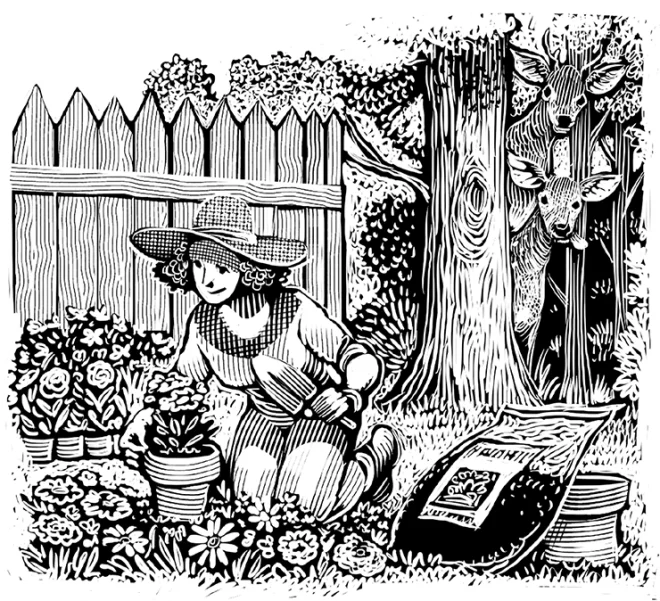
Studies have shown that gardening is therapeutic. It boosts our bodies’ own mood-enhancing chemicals, serotonin and dopamine. I know I need all the therapy I can get, and when I’m up to my elbows in black dirt and peat moss, I’m as happy as a pig in mud. (Do you suppose pigs have high dopamine levels?)
One morning this past Spring, I was more than ready for a session with Dr. Dirt. As I grabbed my wallet and keys, my husband looked up from the TV to ask where I was going. When I told him I was headed to the garden center, he suggested that I limit my spending. I slammed the door behind me, snarling, “Gardening is cheaper than marriage counseling! It’s my therapy. Remember?” (See how much I need it?)
I spent countless hours digging and planting that week, creating picture-perfect flowerbeds and planters. When I was finished, my yard looked like a magazine cover. I should’ve taken a picture. I really should have, because less than 12 hours after the last pot had been planted, the local deer population discovered I had opened an all-night buffet.
The next morning, I stepped onto the front porch and discovered the carnage. “What the heck?” I exclaimed. Not a single blossom remained. The begonias had been bitten off and the dahlias were decapitated. Even the rose bush had been nibbled down to a nubbin—thorns and all.
All my hours of therapy had been undone. Now I needed even more! Before I scheduled my next session, though, I reached out to friends and family for advice. “Help!” I asked. “What plants will deer avoid?”
“Try daisies,” one friend suggested. “Deer won’t touch daisies.” She offered a few dozen plants from her own yard, which I happily transplanted. They thrived in their sunny location, and within a week, they bloomed. At which time, the deer snuck in and ate them.
I also transplanted rhubarb from my mother’s yard. This had to be foolproof. As a kid, I was warned that rhubarb leaves were poisonous. Who in their right mind would dare eat them? A herd of rotten deer, that’s who. If my calculations are correct, they consumed enough rhubarb to make approximately 27 pies.
Years ago, my grandmother told me that deer hate poppies. So I planted poppies. Just as the fuzzy buds started to open, the deer discovered them. They didn’t eat them. They vandalized them, chomping off every bud and spitting them into the grass. Grandma was right. Deer hate poppies.
According to the Internet, sprinkling minced garlic around flowers will discourage animals from eating them. When I tried it, I created two things: a yard that smells like Olive Garden and deer that crave Italian food.
After the garlic failure, I decided I wasn’t going to take it any-more. It was time to fight back. Time to arm myself and protect what was mine. I drove to the hardware store and purchased a bottle of deer repellant.
Weapon in hand, I marched into my yard, ready for battle. I glanced at the directions: Shake well before use …blah blah blah. I read no further.
I approached the flowerbed, shook the can, and fired. Rather than the direct stream pictured on the label, the nozzle puffed out a fine mist, which drifted to the ground and left the plants untouched. Hmm. I tried again. This time I squeezed the spray trigger over and over in rapid-fire succession.
At that moment, a breeze blew through my yard, and I abruptly learned that I was downwind of the plant I was shooting at. The breeze blew the mist back at me, soaking my hands and arms and confirming that my gag reflex at least is in fine working order.
Throughout my life, I have encountered a variety of violent odors. A dead mouse in the heater vent. A bowl of coleslaw that had been lost in the refrigerator for six months. Babies who pooped up their backs and into their own hair. But compared to the stench that now covered my skin, my prior odiferous experiences would qualify as aromatherapy.
If you’re wondering what the main ingredient in deer repel-lent is, it’s putrefied eggs. Say that out loud and try not to gag. Putrefied. Eggs.
I dropped the bottle, ran into the kitchen, and slathered myself from wrists to pits with dish soap. Ack! No amount of lathering, rinsing, or repeating the two erased the smell. Not only did the putrid mist end up on my arms, but also on my clothes and in my hair. And that breeze? Yeah, it carried the stench through the open windows and into my house.

Once the stink cloud lifted and the initial shock wore off, I ventured back outside to finish what I’d started. This time, though, I took a closer look at the directions:
- Twist nozzle counterclockwise to ensure steady stream.
- Do not use in windy or enclosed environments.
- Avoid contact with skin and clothing.
Whadda ya know? Directions—I guess they work better if you read them.
I spent the next 15 minutes spritzing and gagging my way through the yard, applying the solution to the remaining flowers and shrubs. Two days later, I repeated the process. And you know what? It worked! Not a single deer came back to nibble my plants. Because they were putrefied.
You know something else? Deer repellent doesn’t protect plants from hail. Bucketloads of marble-sized hail that turned my yard into a shredded salad of greenery.
Like I said, gardening is good therapy. Shock therapy, mostly. At least when I try it. ❖


 Previous
Previous

